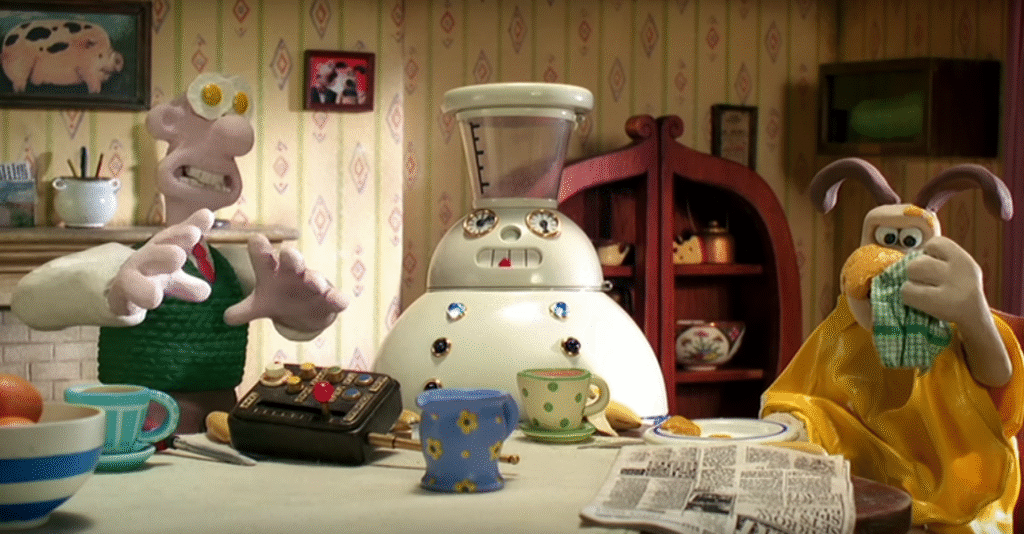In a world obsessed with efficiency, where productivity is measured in microseconds and smart devices orchestrate our mornings with sterile precision, the arrival of a real-life Wallace & Gromit-style breakfast machine feels like a small but meaningful act of rebellion. Crafted with a mixture of absurdity and genius, this contraption doesn’t just pour your tea and toast your bread—it does so with theatrical flair, flinging jam across the kitchen in a midair arc that lands, improbably, on a flying slice of toast.
It’s not a joke. It’s not a prop. It’s a genuine engineering marvel, inspired by Aardman Animations’ most beloved duo: the nervous, inventive Wallace and his loyal, eye-rolling dog Gromit. Their homemade gadgets—especially their morning routines—have long captured imaginations for their blend of Rube Goldberg logic and British domestic charm. But while many have smiled at the on-screen breakfast ballet, few have dared to manifest it in real life.
Until now.
This editorial explores not only the machine itself—its components, mechanics, and spectacle—but also the cultural, emotional, and philosophical significance of such an invention. Because in building a breakfast machine that flings jam through the air just to make a point, we confront the strangely beautiful contradiction at the heart of human invention: that sometimes, the most inefficient solution is the most meaningful one.
Reanimating the Absurd
To understand why such a machine matters, one must first understand what it does. The real-life version borrows heavily from the spirit (and sequence) of Wallace’s original device from The Wrong Trousers. Morning begins not with a quiet alarm, but with a phonograph needle dropping onto a vinyl record of upbeat ragtime jazz. Simultaneously, a network of pulleys awakens, pulling back blackout curtains and launching a series of interlocking actions that include:
- A rubber boot kicking over a canister of birdseed.
- A cuckoo clock triggering a spring-loaded spoon that flings a teabag into a swinging cup.
- A rotating blade lowering bread into a retrofitted toaster attached to a timing belt.
- A pendulum, guided by a precisely angled platform, sending a dollop of strawberry jam flying through the air to land just so on a slice of toast caught in mid-descent.
Each action is precisely timed yet gloriously overcomplicated. There are no microchips. There’s no app. It’s analog absurdism at its most glorious. A symphony of gears, wires, counterweights, and intuition—built not to save time but to make time worth savoring.
In a culture increasingly defined by invisible mechanisms, there’s something profoundly grounding about watching a machine perform labor visibly and comically. Here, labor is not minimized—it is dramatized.
Engineering as Theater
The technical prowess required to make this machine function is no small feat. While Wallace’s animations were products of stop-motion fantasy, this real-world iteration required intense mechanical engineering, trial and error, and a deep understanding of Newtonian physics. The project was led by a multidisciplinary team: part kinetic sculptor, part mechanical engineer, part breakfast romantic.
The jam trajectory alone involved over 30 prototype tests. At issue was not just velocity or distance but the consistency of the jam itself. Too runny, and it splattered. Too thick, and it refused to launch. The eventual solution? A custom-blended conserve stored in a temperature-controlled chamber that adjusted viscosity based on ambient room heat.
The toast-catcher mechanism, meanwhile, was inspired by carnival claw machines—except reversed. A curved track uses gravity and centripetal force to slow the toast mid-flight, positioning it at a precise angle to intercept the jam dollop at apogee. The result is nothing short of performance art.
This isn’t convenience. It’s choreography.
What makes it radical isn’t the engineering—it’s the choice to engineer something whose only goal is to delight.
Domestic Surrealism
There is a long and dignified history of art that reimagines the home as a space of surreal possibility. From Dadaist furniture to Pee-wee’s Playhouse, the idea that the domestic sphere can harbor the fantastical has endured because it elevates the everyday. Wallace & Gromit are heirs to this tradition, and this real-life breakfast machine is a new chapter in that legacy.
Toasters aren’t supposed to be exciting. They’re functional. The same can be said for kettles, egg cups, or marmalade. But what happens when we invest these objects with narrative? When we build machines that don’t just serve us, but interact with us in playful ways?
The breakfast machine is not a machine, then. It is a conversation. It’s your house talking back to you with a grin.
It also functions as a subversion of capitalist time logic. In a world where everything must be faster, more optimized, and less human, this machine slows us down. It insists on ceremony over speed. It says: your morning matters not because it is efficient, but because it is yours.
From Animation to Anima
There is something profound about bringing a cartoon to life—not through CGI or augmented reality, but through old-school gears and counterweights. It’s about giving “anima”—life force—to what was once imagined. Wallace, the character, is a man defined by whimsy and obsession. His inventions always border on the ridiculous but remain lovable because they reflect his desire to create joy. Not profit. Not power. Just joy.
To imitate that ethos in the real world is to challenge our contemporary assumptions about invention. It’s not about “what problem are you solving?” It’s about “what feeling are you invoking?”
The Philosophy of Play
What this machine truly offers—beyond toast—is a model for how to live differently. In the midst of political fatigue, digital surveillance, and environmental uncertainty, the most radical thing we might do is choose play. To build needlessly intricate machines. To paint the walls in colors we can’t name. To throw jam through the air and call it breakfast.
There’s something sacred about that kind of play. It is a reclaiming of imagination in a world that often seeks to commodify it. It’s a reminder that not all things need justification. That sometimes, a flying piece of toast is enough.
This real-life Wallace & Gromit machine belongs to that rare lineage of inventions—alongside Joseph Cornell boxes, Marcel Duchamp readymades, and Wes Anderson train cars—that exist purely to remind us of possibility. And in that reminder, they nourish not just the body, but the soul.
Ideology
The real-life Wallace & Gromit breakfast machine doesn’t change the world in any grand way. It doesn’t solve hunger, or revolutionize industry, or generate massive revenue. What it does is more intimate. It transforms the most mundane moment of your day into a small, delightful epic.
And maybe that’s the kind of change we need more of.
In the end, the jam hits the toast. The toast lands on your plate. You laugh—maybe a little, maybe a lot. And for a moment, the world feels less brutal. It feels, impossibly, like a place where art, breakfast, and absurdity can all live under the same roof.
No comments yet.








